STUDENT EVALUATION OF THE SOFTWARE IN THE AT&T TEACHING THEATER
中职学校学生综合评价系统的设计与实现

摘要摘要中职院校学生综合评价是当前教育信息化的重要内容之一。
通在中职学校以及其他院校结合学校自身实际情况研发并应用学生综合评价系统,提供对学生全面、真实、科学、有效的测评标大厦标准以及测评手段,可以较大程度上提高学生素质,起到工欲善其事,必先利其器的效果。
另外从学校和教师角度,通过开发学生综合评价系统,对于中职院校的管理以及教师工作自动化的展开都有较大促进,从学生兴趣角度,可以使广大中职学生有提高自身素质的明确动力,提高教学效果,从长远上保证就业的能力储备。
本系统包含权限与用户身份管理模块、学生信息查询模块、学生综合评价考评模块、辅导员学生管理模块几个功能模块,主要关键技术是利用了基本的层次分析方法等方法规划了在职中职学生的综合素质评价体系,同时提供了合理可行的中职学生综合评价的指标体系,建立了系统的评测模型并进行了实现。
本文采用的主要技术手段是PHP开发以及数据库技术,关键技术中则运用了数据库挖掘技术。
本文完成了系统的体系架构和详细设计,在Chrome浏览器以及数据库Windows Server2008上进行了原型系统实现。
本文完全按照标准的软件工程研发流程,从系统的可行性分析入手,进行了详尽的系统需求论证,撰写了需求报告,分析了整个系统的业务和数据流程,然后根据不同的用户群绘制了用例图,分析了系统的功能模块,采用多层架构体系,然后继续进行详细的功能设计和数据库设计以及界面设计等,最终经过系统开发和测试,才搭建了系统的原形系统。
经过系统测试,系统有较好的综合评价结果。
本系统已经在笔者所在学校的教务管理部门以及学生管理部门开始小范围的试用,当前的实验证明,本文提出的中职学生综合素质测评方案和开发的原型系统具有一定的效果,可以对于管理自动化提供较大的帮助。
关键词:综合评价;指标分析;中职院校;教育信息化ABSTRACTComprehensive evaluation of students in vocational colleges is one of the important contents of current educational information.Through the development of the comprehensive evaluation system,the students will be provided a comprehensive,real, scientific and effective evaluation standard and evaluation means,which can improve the quality of students to a large extent.Good tools are prerequisite to the successful execution of a job.To be good at work,we must first of its effect.In addition,from the perspective of schools and teachers,to develop a comprehensive evaluation system for students has a greater promotion for the both management of vocational colleges and the automation of teachers’work.From the perspective of student interest,it makes the majority of secondary vocational students have motivation to improve their own quality so that the teaching effect can be improved.Meanwhile It ensures the reserve of talent in long term.This system includes several function modules of authority and user identity management module,student information query module,student comprehensive evaluation evaluation module and counselor student management module.The main key technology is to use the basic level analysis method and so on.The comprehensive quality evaluation system is provided,and the index system of comprehensive evaluation of middle vocational students is provided,and the evaluation model of the system is established and realized.The main means being adopted is PHP development and Database,and the key tech is Database Mining.This paper completed the system architecture and detailed design and implemented the prototype system in the Chrome browser and database Windows Server2008.Based on the standard software engineering R&D process,this paper starts from the feasibility analysis of the system,carries out the detailed system requirements demonstration,composes the demand report,analyzes the whole system business and the data flow,and then draws the use case according to the different user group Figure, the system of functional modules,the use of multi-tier architecture,and then continue to carry out detailed functional design and database design and interface design,and ultimately through the system development and testing,only to build the system prototype system.After the system test,the system has a preferable comprehensiveevaluation results.The system has been in the school's educational administration departments which the author serves and a small trial has been run in the student management departments. The current experiment has proved that the evaluation program and the development of the prototype system put forward by this article have a certain effect and provide greater help for management automation.Key words:comprehensive evaluation;index analysis;secondary vocational school;education informationization目录第一章绪论 (1)1.1研究背景与意义 (1)1.2国内外研究现状 (2)1.2.1国内外学生综合评价研究进展 (2)1.2.2国内外评价系统技术进展 (3)1.2.3国内外数据库技术进展 (3)1.3本文的研究内容与研究方法 (4)1.4本文的组织结构 (5)第二章相关理论与技术 (7)2.1PHP的理论和技术框架 (7)2.1.1基本定义 (7)2.1.2开发框架 (7)2.2多层体系架构 (7)2.2.1基本定义 (7)2.2.2架构内容 (7)2.3开发语言与数据库基础 (9)2.4中职学生综合评价体系 (9)2.5用户指标分析 (11)2.5.1综合指标分析 (11)2.5.2中职院校综合评价数学模型 (12)2.6本章小结 (12)第三章中职学校学生综合评价系统的需求分析 (13)3.1系统设计目标与原则 (13)3.2系统可行性分析 (13)3.3中职院校的信息化需求 (15)3.4系统需求分析 (16)3.4.2系统业务与数据流程分析 (16)3.4.3用例图分析 (18)3.4.4功能模块需求 (20)3.5本章小结 (20)第四章中职学校学生综合评价系统设计 (21)4.1系统设计目标 (21)4.2系统设计原则 (21)4.3系统概要设计 (22)4.3.1整体体系结构 (22)4.3.2系统网络架构 (23)4.4系统详细设计 (23)4.4.1系统登录模块 (23)4.4.2学生查询模块 (25)4.4.3综合素质评价管理模块 (25)4.4.4教师成绩管理模块 (27)4.4.5辅导员管理模块 (27)4.4.6系统管理模块 (28)4.5系统数据库设计与操作 (28)4.5.1数据库概念模型 (29)4.5.2数据库逻辑模型 (29)4.5.3数据库物理模型 (29)4.5.4数据表设计 (30)4.5.5数据库部署与连接 (31)4.6本章小结 (32)第五章中职学校学生综合评价原型系统实现 (33)5.1系统开发环境 (33)5.1.1系统安装环境 (33)5.1.2配置环境 (33)5.2系统界面设计 (34)5.2.1界面设计规范 (34)5.2.2界面设计流程 (34)5.2.3系统主界面 (35)5.3系统关键技术实现 (35)5.3.1数据库连接 (35)5.3.2系统框架MVC (36)5.4系统主要功能模块实现 (38)5.4.1添加学生个人基本信息 (38)5.4.2修改学生个人基本信息 (39)5.4.3系统登录模块 (41)5.4.4学生查询模块 (42)5.4.5综合素质评价管理模块 (43)5.4.6教师成绩管理模块实现 (46)5.4.7辅导员管理模块实现 (47)5.5本章小结 (47)第六章中职学校学生综合评价系统测试 (48)6.1测试目的与测试环境 (48)6.1.1系统测试目的 (48)6.1.2性能指标 (48)6.1.3系统测试环境 (49)6.2测试方法 (50)6.2.1系统功能测试 (50)6.2.2系统性能测试 (51)6.3测试结果 (51)6.4测试结果分析 (53)6.5本章小结 (54)第七章总结与展望 (55)7.1本文研究工作总结 (55)7.2未来工作展望 (56)致谢 (57)参考文献 (58)第一章绪论第一章绪论1.1研究背景与意义目前我国的中等职业教育指的是实施中等职业教育的职高、中专等学校,其招生对象为初中毕业生及具有同等学历的学生,学制一般为三年,学生毕业后获得中专学历。
《大学英语》课件
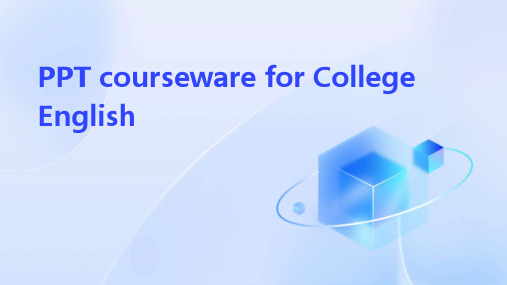
Basic reading comprehension
要点一
要点二
Comparative Analysis
Enhance students to compare and contrast their own culture with those reported in the texts they are studying to enhance their cultural awareness
Advanced listening comprehension
further improve students' ability to understand English at a high level, including complex senses, advanced vocabulary, and suggestive expressions
Translation Techniques
Teach students translation techniques such as literal translation, free translation, and adaptation
Context Understanding
Help students understand the cultural and historical backgrounds of the source texts they are translating to enhance their translation accuracy
高洪德英语学习活动观及其在英语教学中的实践(成都 宽)课件

Through participation in collaborative and problem-solving activities, students develop critical thinking, collaboration, and innovation, essential skills for the 21st century.
02
The core concept of English learning activity view
Gao Hongde believes that students should be the center of English learning activities, and teachers should design activities based on students' needs, interests, and learning styles.
Teachers should design activities that are closely related to students' real life experiences and interests, encourage them to participate actively, and help them gain practical experience.
Gao Hongde's view on English learning activities emphasizes the integration of language knowledge and skills into meaningful communicative activities, enabling learners to acquire English through participation in interactive and situated learning experiences.
【精品】【英文简历必备---获奖、荣誉英文翻译】三好学生翻成threegoodstudents?别丢人了行吗!

“三好学生”翻成three good students?噢,no! 来看看怎么翻吧。
做简历超实用的中国特色表达一扫光…一. 校级奖项、称号三好学生Merit Student学习优秀生Model Student of Academic Records突出才能奖Model Student of Outstanding Capacity先进个人Advanced Individual/Outstanding Student优秀学生干部Excellent Student Cadre优秀共青团员Excellent League Member优秀志愿者Outstanding Volunteer先进班集体Advanced Class优秀团干OutstandingLeague Cadres学生协会优秀干部Outstanding cadres of Student Association学生协会工作优秀个人Outstanding Individual of Student Association精神文明先进个人Spiritual Advanced Individual社会工作先进个人Advanced Individual of Social Work文体活动先进个人Advanced Individual of Cultural and Sportsactivities道德风尚奖Ethic Award精神文明奖High Morality Prize最佳组织奖Prize for The Best Organization1 突出贡献奖Prize for The Outstanding Contribution工作创新奖Prize for The Creative Working2团队建设奖Prize fo rThe Team Contribution二、各系比赛与奖项话剧比赛Drama Competition英语演讲比赛English Speech Contest黑板报设计大赛Blackboard Poster Design Contest文明宿舍Outstanding Dormitory诗歌朗诵比赛Poetry Recitation Contest诗歌创作比赛Poetry Creation Contest摄影大赛Photography Competition报刊比赛PressWriting Contest足球比赛Football Match网络工程师Network Engineer Certification知识风采比赛Knowledge CompetitionPPT 课件制作大赛Courseware Design Competition辩论赛Debate Competition党团知识竞赛Knowledge Contest on the Party and the League模拟法庭Mock Court征文比赛Essay Competition网页设计大赛Web Page Design Competition辩论赛Debate Competition软件设计大赛Software Design Competition3多媒体课件设计大赛Multimedia Courseware Design Competition网站设计竞赛Web Design Competition演讲比赛Speech Contest电子设计大赛Electronic Design Contest服装设计大赛Garment Design Contest实验技能操作大赛Experiment Skill and Operation Contest友谊篮球赛Friendship Cup Basketball Match十佳学生活动组织Top Ten Student Activities Organization十大学生修身楷模Ten Model Students of Self-cultivation学生科研创新奖Student Award for Research and Innovation棋王大赛Chess Competition女子篮球赛Women's Basketball Match党团知识竞赛Knowledge Contests about the CPC and the CYLC礼仪风采大赛Manner and Etiquette Contest体育文化节Physical Culture Festival相声小品大赛Crosstalk and Sketch Contest三、校运会第一名The First Prize第二名The Second Prize第三名The Third Prize健美操比赛Competitionof Body-building Exercises4校运会篮球比赛Basketball Matches in Sports-meeting校运会男子100米Men ’s 100-metre Race in the Sports-meeting校运会女子100米Women ’s 100-metre Race in the Sports-meeting校运会男子200米Men ’s 200-metre Race in the Sports-meeting校运会女子200米Women ’s 200-metre Race in the Sports-meeting校运会男子1500米Men ’s 1500-metre Race in the Sports-meeting校运会女子800米Women ’s 800-metre Race in the Sports-meeting校运会男女跳高比赛Men/Women ’s High Jump Matches校运会男女三级跳比赛Men/Women ’s Triple Jump Matches校运会男子110米栏Men ’s110-metre Hurdle Race校运会男女铅球Men/Women ’s Shot Put校运会男女标枪Men/Women ’s javelin throwing四、其他活动博客大赛Blog Contest主持人大赛Host Competition十大歌手Top Ten Singers军训优秀通讯员Excellent Correspondent in Military Training军训先进个人Advanced Individual in Military Training十佳社团Top Ten Outstanding Associations突出贡献奖Outstanding Contribution Award工作创新奖Innovation Award5团队建设奖Teamwork Award最佳台风奖Best Stage Style Award最佳人气奖Best Popularity Award优秀组织奖Outstanding Organization Award最佳创意奖Best Creativity Award优秀团体奖Excellent Group Award优秀节目奖Best Program Award十佳新秀奖Top Ten Outstanding Rising Stars Award最具潜质奖Most Potentiality Award最佳才艺奖Outstanding Talent Award最佳气质奖Outstanding Quality Award最佳口才奖Best Eloquence Award最佳演员奖Best ActorAward最佳剧本奖Best ScriptAward优秀会员Excellent Member最佳辩手Best Debater优秀辩手Excellent Debater五、补充学生会Student Union团委会Youth League Committee学生社团Students ’ Association体育部Sports Department文艺部Arts Department学习部Learning Department外联部Public Relations Department宣传部Publicity Department生活部Life Department纪检部Discipline Inspection Department秘书部Secretary Department组织部Organization Department编辑部Editorial Department学生会主席President ofthe Student Union团委会书记Secretary ofthe Youth League Committee团支书League Branch Secretary or Secretary of the Youth League Branch Committee副书记Vice Secretary秘书长Secretary-general学术部干事 a member of the Academic Department宿舍长Head of the dormitory优秀团员Excellent League Member班长Monitor/Class President副班长Vice-monitor6 文体委员Recreation & Sports Secretary学习委员Study Secretary生活委员Life Secretary宣传委员Publicity Secretary生活委员Organization Secretary勤工俭学Work-study Program青年志愿者协会Youth Volunteers Association晚会主持人Host on the entertainment / evening party礼仪队Reception Team/ Protocol Team综合测评Comprehensive Evaluation of Students’ Performance预备党员Probationary Party Member入党积极分子Applicant for Party Membership综合素质优秀学生Excellent Student of Comprehensive Quality优秀青年志愿者Outstanding Young Volunteer校园十杰Ten Prominent Youth on Campus / Top Ten Youth on Campus品学兼优的学生Student of Good Character and Scholarship军训MilitaryTraining艺术团Art Troupe义教Voluntary Teaching迎新晚会Welcome Party for the Freshmen招聘会Job Fair广播站Broadcasting Station7 学生处Students Affairs Department社会活动social/public activities课外活动extracurricular activities社会实践social practice学术活动academic activities籍贯native place家庭状况family status教育程度educational background团结合作Solidarity and Cooperation创新能力Creative Ability沟通能力Communicational Ability兼职Part-time Job成绩优异Outstanding Academic Results学业技能Academic Skills思想品行Ideological Morality文体表现Arts and Sports Performance实习Internship奖学金scholarship8。
学生评估-英文版
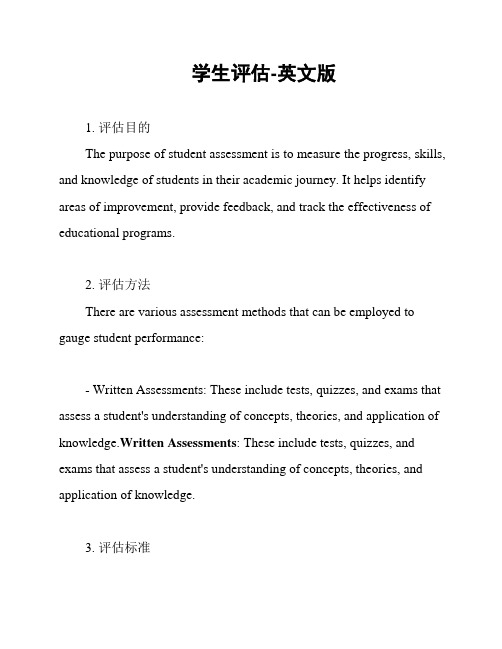
学生评估-英文版1. 评估目的The purpose of student assessment is to measure the progress, skills, and knowledge of students in their academic journey. It helps identify areas of improvement, provide feedback, and track the effectiveness of educational programs.2. 评估方法There are various assessment methods that can be employed to gauge student performance:- Written Assessments: These include tests, quizzes, and exams that assess a student's understanding of concepts, theories, and application of knowledge.Written Assessments: These include tests, quizzes, and exams that assess a student's understanding of concepts, theories, and application of knowledge.3. 评估标准To ensure fairness and consistency in student assessment, clear and objective criteria should be established:- Rubrics: Rubrics provide a detailed breakdown of expectations and criteria for each assessment task, enabling both students and teachers to have a clear understanding of the evaluation process.Rubrics: Rubrics provide a detailed breakdown of expectations and criteria for each assessment task, enabling both students and teachers to have a clear understanding of the evaluation process.- Timely Feedback: Providing timely feedback allows students to reflect on their performance, identify areas for improvement, and make adjustments to their learning strategies.Timely Feedback: Providing timely feedback allows students to reflect on their performance, identify areas for improvement, and make adjustments to their learning strategies.4. 评估结果应用The results obtained from student assessments can be used in various ways:- Individual Student Feedback: Providing individual feedback helps students understand their strengths and areas for improvement, allowing them to set personal goals and work towards their academic development.Individual Student Feedback: Providing individual feedback helps students understand their strengths and areas for improvement, allowing them to set personal goals and work towards their academic development.- Curriculum Development: Assessment results can help identify gaps or weaknesses in the curriculum, enabling educators to modify and enhance teaching strategies and content to better support student learning.Curriculum Development: Assessment results can help identify gaps or weaknesses in the curriculum, enabling educators to modify and enhance teaching strategies and content to better support student learning.- Program Evaluation: Ongoing assessment data can be used to evaluate the effectiveness of educational programs and make informed decisions for improvement.Program Evaluation: Ongoing assessment data can be used to evaluate the effectiveness of educational programs and make informed decisions for improvement.- Recognition and Support: Assessment results can be used to identify high-achieving students who may benefit from additional challenges or rewards, as well as students who may require extra support and intervention.Recognition and Support: Assessment results can be used to identify high-achieving students who may benefit from additional challenges or rewards, as well as students who may require extra support and intervention.In conclusion, student assessment plays a crucial role in measuring progress, providing feedback, and tracking the effectiveness of educational programs. By employing various assessment methods with clear criteria, educators can ensure fair evaluation and support student learning and development effectively.。
学生评价老师的好处英语作文

Student Feedback in Teacher Evaluation: ItsBenefitsIn the educational system, evaluation is a crucial aspect that ensures continuous improvement and excellence. Traditionally, teachers have been evaluated by their superiors or peers, focusing primarily on teaching methods, lesson plans, and classroom management. However, in recent years, the inclusion of student feedback in teacher evaluation has emerged as a significant practice. This approach not only provides a more comprehensive understanding of teaching effectiveness but also brings numerous benefits to the overall educational process.Firstly, student feedback offers a direct and honest assessment of teaching quality. Students, as the recipients of instruction, have a unique perspective on how well teachers are meeting their needs and expectations. Their feedback provides insights into whether the teaching methods are engaging, the content is relevant, and the classroom environment is conducive to learning. This direct feedback loop enables teachers to identify areas ofstrength and weaknesses, thus allowing them to make timely adjustments to improve their teaching practices.Secondly, student feedback fosters a sense of accountability and responsibility among teachers. By knowing that their performance is being evaluated by their students, teachers are more likely to remain engaged and committed to their teaching duties. This sense of accountability encourages teachers to be more innovative, responsive, and proactive in meeting the learning needs of their students.Moreover, student feedback promotes a two-way communication between teachers and students. It encourages open dialogue and creates an environment where studentsfeel comfortable voicing their opinions and suggestions. This interactive communication not only helps teachers to understand their students better but also empowers students to take ownership of their learning process.Additionally, student feedback acts as a motivator for teachers to excel in their craft. Positive feedback can boost a teacher's morale and encourage them to continue with effective practices, while negative feedback providesan opportunity for reflection and improvement. This continuous cycle of evaluation and improvement can lead to a more effective and satisfying teaching-learning experience for both teachers and students.Lastly, the inclusion of student feedback in teacher evaluation supports a culture of continuous improvement and innovation in education. It encourages teachers to experiment with new teaching methods, explore innovative technologies, and adapt to changing student needs. This culture of innovation is crucial for preparing students to face the rapidly evolving world beyond the classroom.In conclusion, the integration of student feedback in teacher evaluation offers a comprehensive understanding of teaching effectiveness and brings numerous benefits to the educational system. It promotes teacher accountability, fosters two-way communication, acts as a motivator for teachers, and supports a culture of continuous improvement and innovation. By embracing this practice, we can create a more engaging, responsive, and effective learning environment for all students.**学生评价老师的好处**在教育体系中,评价是确保持续改进和卓越性的重要环节。
教学评一体化在英语词汇教学中的应用
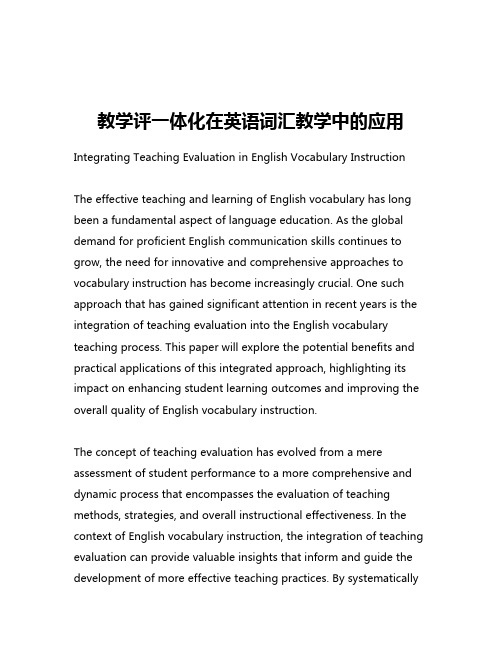
教学评一体化在英语词汇教学中的应用Integrating Teaching Evaluation in English Vocabulary InstructionThe effective teaching and learning of English vocabulary has long been a fundamental aspect of language education. As the global demand for proficient English communication skills continues to grow, the need for innovative and comprehensive approaches to vocabulary instruction has become increasingly crucial. One such approach that has gained significant attention in recent years is the integration of teaching evaluation into the English vocabulary teaching process. This paper will explore the potential benefits and practical applications of this integrated approach, highlighting its impact on enhancing student learning outcomes and improving the overall quality of English vocabulary instruction.The concept of teaching evaluation has evolved from a mere assessment of student performance to a more comprehensive and dynamic process that encompasses the evaluation of teaching methods, strategies, and overall instructional effectiveness. In the context of English vocabulary instruction, the integration of teaching evaluation can provide valuable insights that inform and guide the development of more effective teaching practices. By systematicallyanalyzing the outcomes of vocabulary lessons, teachers can identify areas of strength and weakness, allowing them to refine their instructional approaches and better cater to the diverse learning needs of their students.One of the key advantages of integrating teaching evaluation into English vocabulary instruction is the ability to personalize and differentiate the learning experience. Through regular assessment and feedback, teachers can gain a deeper understanding of how individual students respond to different teaching methods and strategies. This information can then be used to tailor the vocabulary instruction, incorporating a variety of techniques and resources that cater to the unique learning styles and preferences of each student. By fostering a more personalized learning environment, students are more likely to engage actively with the vocabulary content, leading to enhanced retention and application of the learned words.Moreover, the integration of teaching evaluation can also contribute to the development of a more collaborative and reflective teaching culture. By encouraging teachers to regularly assess the effectiveness of their vocabulary instruction, this approach fosters a spirit of continuous improvement and professional development. Teachers can engage in peer-to-peer discussions, share best practices, and collectively explore innovative strategies to address any identified challenges in vocabulary teaching. This collaborative environmentnot only enhances the quality of instruction but also promotes a sense of ownership and shared responsibility among teachers, ultimately benefiting the students they serve.Another significant advantage of integrating teaching evaluation into English vocabulary instruction is the potential to enhance student motivation and engagement. When students perceive that their learning experiences are being actively evaluated and refined, they may feel a greater sense of investment and ownership in the learning process. This can lead to increased motivation, as students recognize that their feedback and performance are valued and directly contribute to the improvement of the instructional methods. As a result, students may be more inclined to actively participate in vocabulary-related activities, leading to deeper understanding and more effective retention of the learned words.Furthermore, the integration of teaching evaluation can also facilitate the alignment of vocabulary instruction with broader educational goals and standards. By aligning the evaluation of vocabulary teaching with established frameworks and benchmarks, teachers can ensure that their instructional practices are not only effective but also consistent with the overarching objectives of the language curriculum. This alignment can foster a more cohesive and comprehensive approach to language education, where vocabulary instruction is seamlessly integrated into the broader languagelearning experience.In practical terms, the integration of teaching evaluation into English vocabulary instruction can take various forms. One approach might involve the implementation of regular formative assessments, such as quizzes, classroom activities, and performance-based tasks, to gauge student progress and inform instructional adjustments. Teachers can also incorporate peer-to-peer evaluation, where students provide constructive feedback on the effectiveness of vocabulary teaching methods, thereby enhancing the collaborative nature of the learning environment.Additionally, the integration of teaching evaluation can involve the use of technology-driven tools and platforms. For instance, online learning management systems can provide valuable data on student engagement, comprehension, and skill development, allowing teachers to monitor and adapt their vocabulary instruction accordingly. Furthermore, the incorporation of digital assessment tools, such as adaptive learning software and interactive vocabulary games, can provide real-time feedback and personalized learning experiences for students, further enhancing the effectiveness of the integrated approach.It is important to note that the successful integration of teaching evaluation into English vocabulary instruction requires acomprehensive and strategic approach. This may involve providing professional development opportunities for teachers to enhance their skills in assessment, data analysis, and instructional design. Additionally, the establishment of clear evaluation frameworks, aligned with the specific learning objectives and desired outcomes of vocabulary instruction, can ensure a consistent and meaningful assessment process.In conclusion, the integration of teaching evaluation into English vocabulary instruction holds immense potential to enhance the quality and effectiveness of language learning. By leveraging the insights gained from regular assessment and feedback, teachers can develop more personalized, collaborative, and engaging vocabulary teaching practices, ultimately leading to improved student learning outcomes and a more comprehensive language education experience. As the demand for proficient English communication skills continues to grow, the adoption of this integrated approach can serve as a powerful tool in empowering both teachers and students to achieve their language learning goals.。
英语教育格言

英语教育格言Teach all knowledge to all people. 格言是可以作为人们行为规范的言简意赅的语句,是人们机智的精华、众人汇成的睿智、是指导人生走向成功之路的法宝,时刻激励人生取得进步。
下面小编给大家整理了一些英语教育格言请笑纳!英语教育格言11、把一切知识教给一切人。
Teach all knowledge to all people.2、教育是国家的主要防御力量。
Education is the chief defense of nations.3、培养人就是培养他对前途的希望。
Cultivation is his hopes for the future.4、用千百倍的耕耘,换来桃李满园香。
With one thousand times for the peach garden sweet.5、前后不一致是教育中最严重错误之一。
Inconsistent is one of the most serious mistakes in education.6、让每一个学生在学校里抬起头来走路。
Let every student in the school looked up and walk.7、愿乘风破万里浪,甘面壁读十年书。
Let the wind to break the waves, side wall read ten years.8、给学生一个世界,给老师一片天空。
Give students a world, a piece of the sky to the teacher.9、教育的艺术是使学生喜欢你所教的东西。
The art of education is to make students like what you taught.10、评价不是为了排队,而是为了促进发展。
Evaluation is not to queue, but in order to promote development.11、不会触类旁通,研究哪一门学问都难有成就。
英语作文-中等教育行业的学生评价制度与学业发展规划

英语作文-中等教育行业的学生评价制度与学业发展规划In the realm of secondary education, the student evaluation system and academic development planning play pivotal roles in shaping the educational journey and future prospects of young learners. The evaluation system, often seen as a measure of academic performance, extends beyond mere grades; it encompasses a comprehensive assessment of a student's knowledge, skills, and competencies. Meanwhile, academic development planning serves as a roadmap, guiding students through their educational path and preparing them for higher education and career choices.Evaluation Systems: A Multifaceted Approach。
The modern student evaluation system in secondary education is multifaceted, incorporating various methods to assess a student's performance. Traditional examinations and tests remain a staple, providing quantitative data on a student's understanding of the curriculum. However, this is complemented by qualitative assessments such as project work, presentations, and participation in class discussions, which offer insights into a student's critical thinking, creativity, and collaborative skills.Continuous assessment is another integral component, where teachers monitor progress over time, rather than relying solely on end-of-term exams. This approach allows for timely interventions and support, ensuring that students remain on track with their learning objectives. Feedback plays a crucial role in this process, offering students constructive criticism and recognition of their efforts, fostering a growth mindset and encouraging self-improvement.Academic Development Planning: Charting the Course。
大学英语作文-学生评价老师 Students’Evaluation of Teachers
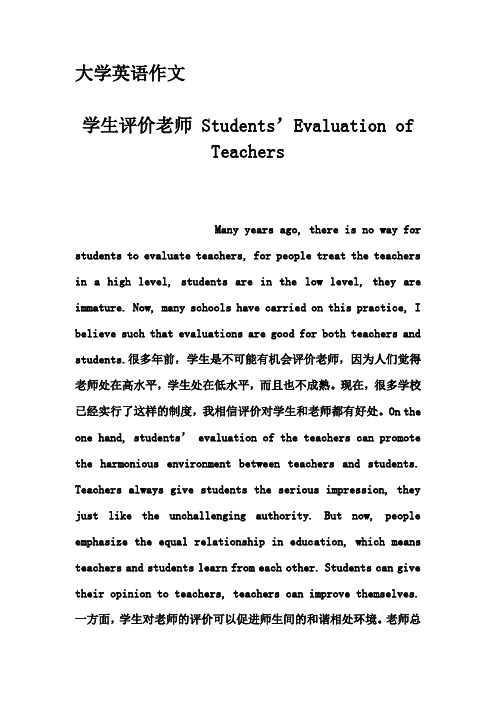
大学英语作文学生评价老师 Students’Evaluation ofTeachersMany years ago, there is no way for students to evaluate teachers, for people treat the teachers in a high level, students are in the low level, they are immature. Now, many schools have carried on this practice, I believe such that evaluations are good for both teachers and students.很多年前,学生是不可能有机会评价老师,因为人们觉得老师处在高水平,学生处在低水平,而且也不成熟。
现在,很多学校已经实行了这样的制度,我相信评价对学生和老师都有好处。
On the one hand, students’ evaluation of the teachers can promote the harmonious environment between teachers and students. Teachers always give students the serious impression, they just like the unchallenging authority. But now, people emphasize the equal relationship in education, which means teachers and students learn from each other. Students can give their opinion to teachers, teachers can improve themselves.一方面,学生对老师的评价可以促进师生间的和谐相处环境。
外研版七年级英语教材

The textbook incorporates authentic language materials, task based activities, and interactive exercises to engage students in active learning It also emphasizes the integration of language skills and cultural awareness
Cultural awareness and cross cultural communication capability
Cultural awareness
Students should learn about the history, traditions, customs, values, and lifestyles of English speaking countries They should understand the differences between Chinese and Western cultures and be able to apply cultural diversity
Vocabulary
Students should learn and master at least 1200 new words and phrases, as well as their basic usage and settlements They should also be able to use these words and phrases flexibly in different contexts
Guidance for teachers
英语作文电脑在学生中的作用
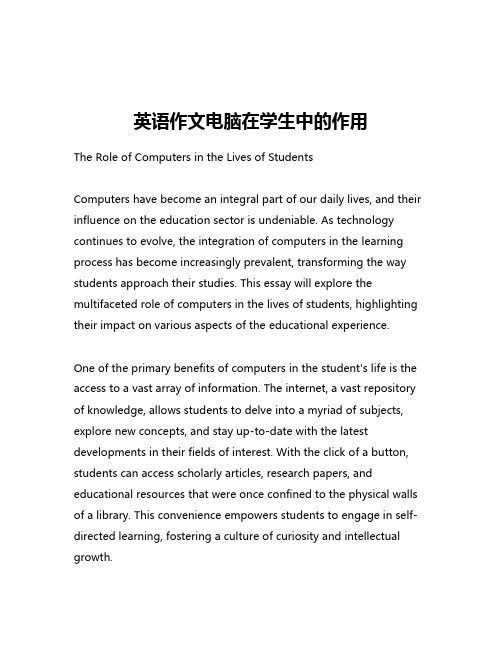
英语作文电脑在学生中的作用The Role of Computers in the Lives of StudentsComputers have become an integral part of our daily lives, and their influence on the education sector is undeniable. As technology continues to evolve, the integration of computers in the learning process has become increasingly prevalent, transforming the way students approach their studies. This essay will explore the multifaceted role of computers in the lives of students, highlighting their impact on various aspects of the educational experience.One of the primary benefits of computers in the student's life is the access to a vast array of information. The internet, a vast repository of knowledge, allows students to delve into a myriad of subjects, explore new concepts, and stay up-to-date with the latest developments in their fields of interest. With the click of a button, students can access scholarly articles, research papers, and educational resources that were once confined to the physical walls of a library. This convenience empowers students to engage in self-directed learning, fostering a culture of curiosity and intellectual growth.Moreover, computers have revolutionized the way students conduct research and complete assignments. Gone are the days of relying solely on physical textbooks and encyclopedias. Students can now access online databases, digital libraries, and specialized search engines to gather information, analyze data, and synthesize their findings. This digital approach to research not only saves time but also encourages critical thinking and analytical skills as students navigate the vast sea of information available at their fingertips.In addition to research, computers have also transformed the way students present their work. Word processing software, such as Microsoft Word or Google Docs, enable students to create well-formatted, visually appealing documents that showcase their knowledge and understanding. The ability to easily edit, format, and incorporate multimedia elements into their assignments has significantly improved the overall quality and professionalism of student work.Furthermore, computers have revolutionized the way students collaborate and communicate with their peers and instructors. Online collaboration tools, such as Google Docs and Microsoft Teams, allow students to work on group projects in real-time, share ideas, and provide feedback to one another. This digital collaboration not only fosters teamwork and communication skills but also prepares students for the workforce, where such skills are highly valued.Another crucial aspect of the computer's role in the student's life is its impact on learning and academic performance. Many educational institutions have adopted the use of learning management systems (LMS), such as Blackboard or Canvas, which provide students with access to course materials, assignment submissions, and grading information. These platforms not only streamline the learning process but also enable students to monitor their progress, seek timely feedback, and engage with course content in a more interactive and organized manner.Moreover, the integration of multimedia and interactive elements in the learning process has significantly enhanced the student's learning experience. Animations, simulations, and educational videos can help students visualize complex concepts, making them more engaging and easier to understand. This multimedia-rich approach caters to different learning styles, allowing students to absorb information more effectively and retain it for longer periods.In the realm of assessment, computers have also played a pivotal role. Online testing and examination platforms have enabled institutions to administer assessments in a more efficient and secure manner. Students can take tests and exams remotely, with features such as automatic grading and immediate feedback, providing them with a more personalized and efficient evaluation process.However, it is essential to acknowledge the potential drawbacks and challenges associated with the increased reliance on computers in the student's life. Issues such as digital distractions, cybersecurity threats, and the risk of technological inequalities can pose significant challenges to the effective integration of computers in the educational landscape.Despite these challenges, the overall impact of computers on the student's life is undeniably positive. By facilitating access to information, enhancing research and collaboration, improving learning experiences, and streamlining assessment processes, computers have become an indispensable tool in the modern educational ecosystem. As technology continues to evolve, the role of computers in the lives of students will only become more prominent, and it is crucial for educational institutions and policymakers to ensure that this integration is managed effectively to maximize the benefits for students.。
学生评价体系英语作文
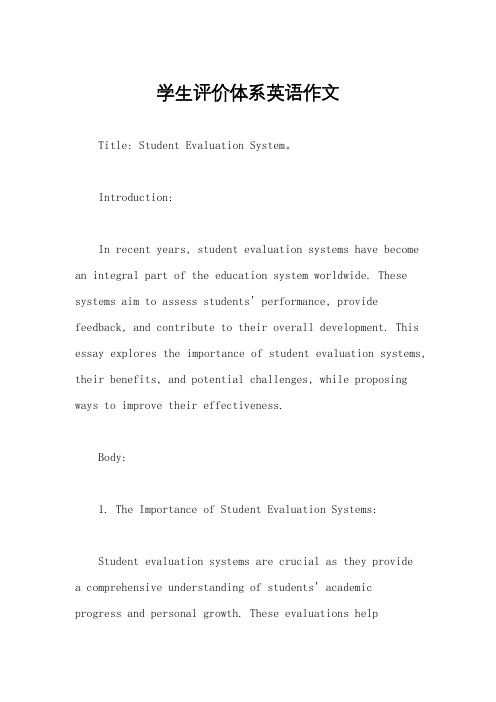
学生评价体系英语作文Title: Student Evaluation System。
Introduction:In recent years, student evaluation systems have become an integral part of the education system worldwide. These systems aim to assess students' performance, provide feedback, and contribute to their overall development. This essay explores the importance of student evaluation systems, their benefits, and potential challenges, while proposing ways to improve their effectiveness.Body:1. The Importance of Student Evaluation Systems:Student evaluation systems are crucial as they providea comprehensive understanding of students' academicprogress and personal growth. These evaluations helpidentify strengths and weaknesses, allowing teachers totailor their teaching methods accordingly. Moreover,student evaluations promote a sense of accountability and encourage students to take responsibility for their own learning.2. Benefits of Student Evaluation Systems:a) Objective Feedback: These systems provide students with unbiased feedback on their performance, enabling themto identify areas that require improvement. Constructive criticism helps students grow and develop their skills.b) Motivation: Regular evaluations motivate students to work harder and strive for excellence. The recognition of their achievements boosts their self-confidence and encourages them to set higher goals.c) Holistic Development: Student evaluation systems assess not only academic performance but also otheressential skills such as critical thinking, problem-solving, and communication. This promotes holistic development andprepares students for future challenges.d) Accountability: Evaluations hold students accountable for their progress and help them understand the importance of consistent effort and dedication in achieving their goals.3. Challenges Faced by Student Evaluation Systems:a) Standardization: Ensuring a fair and standardized evaluation process across different schools and regions can be challenging. Efforts should be made to establish uniform evaluation criteria to maintain consistency.b) Subjectivity: Evaluations involving subjective subjects like arts or literature may be prone to bias. Teachers must be trained to provide objective assessments and avoid personal preferences.c) Overemphasis on Grades: In some cases, evaluation systems tend to focus solely on grades, neglecting other important aspects of a student's development. These systemsshould be designed to assess a student's overall growth rather than just academic achievements.4. Improving the Effectiveness of Student Evaluation Systems:a) Multiple Assessment Methods: Employing a variety of assessment methods, such as written exams, projects, presentations, and group discussions, ensures a comprehensive evaluation of students' skills and knowledge.b) Regular Feedback: Timely and constructive feedbackis crucial for students' improvement. Teachers should provide feedback regularly, highlighting areas of improvement and offering guidance on how to enhance performance.c) Individualized Learning Plans: Student evaluation systems should be used to create individualized learning plans for students. This approach recognizes the unique strengths and weaknesses of each student and tailors teaching methods accordingly.d) Teacher Training: Continuous professional development programs should be conducted to train teachersin effective evaluation methods, ensuring fairness and objectivity.e) Parental Involvement: Parents should be actively engaged in the evaluation process to understand theirchild's progress and provide necessary support and guidance.Conclusion:Student evaluation systems play a vital role in assessing students' progress, providing feedback, and promoting holistic development. By implementing effective evaluation methods, addressing challenges, and involving multiple stakeholders, we can enhance the overall effectiveness of these systems. Ultimately, student evaluation systems should focus on nurturing well-rounded individuals who are equipped with the necessary skills to succeed in their personal and professional lives.。
学生自评英语作文案例
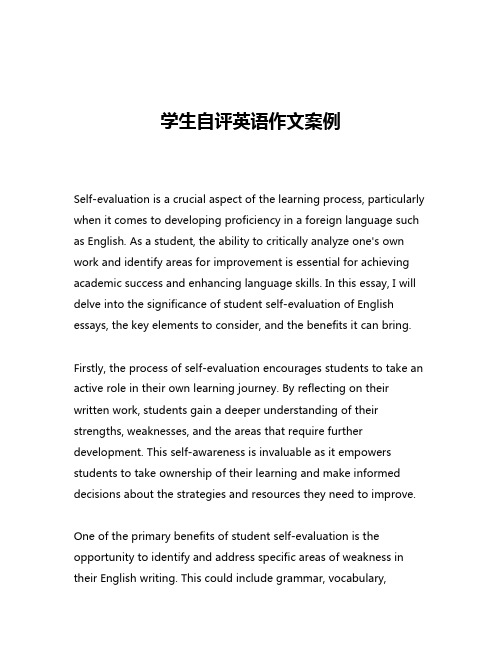
学生自评英语作文案例Self-evaluation is a crucial aspect of the learning process, particularly when it comes to developing proficiency in a foreign language such as English. As a student, the ability to critically analyze one's own work and identify areas for improvement is essential for achieving academic success and enhancing language skills. In this essay, I will delve into the significance of student self-evaluation of English essays, the key elements to consider, and the benefits it can bring.Firstly, the process of self-evaluation encourages students to take an active role in their own learning journey. By reflecting on their written work, students gain a deeper understanding of their strengths, weaknesses, and the areas that require further development. This self-awareness is invaluable as it empowers students to take ownership of their learning and make informed decisions about the strategies and resources they need to improve.One of the primary benefits of student self-evaluation is the opportunity to identify and address specific areas of weakness in their English writing. This could include grammar, vocabulary,sentence structure, organization, or even the coherence and clarity of their arguments. By pinpointing these areas, students can then develop targeted strategies to improve them, such as seeking feedback from teachers, engaging in additional practice exercises, or utilizing language-learning resources.Moreover, self-evaluation encourages students to become more critical thinkers and problem-solvers. As they analyze their own work, they learn to identify and address issues independently, rather than relying solely on the feedback of their teachers. This fosters a sense of autonomy and self-reliance, which are essential skills for success in academic and professional settings.In addition to identifying weaknesses, self-evaluation also allows students to recognize their strengths and build upon them. By acknowledging the aspects of their writing that are effective, students can develop a greater sense of confidence and motivation to continue improving. This positive reinforcement can be particularly valuable for students who may have struggled with English in the past, as it helps them to focus on their progress and celebrate their achievements.Another significant benefit of student self-evaluation is the opportunity to develop metacognitive skills. Metacognition refers to the ability to think about one's own thought processes and learningstrategies. By reflecting on their writing, students learn to analyze their thought patterns, decision-making processes, and the effectiveness of the techniques they employ. This self-awareness can then be applied to other academic and personal endeavors, fostering a lifelong commitment to continuous learning and improvement.Furthermore, the process of self-evaluation can also enhance the relationship between students and their teachers. When students actively engage in self-assessment, they are better equipped to have meaningful discussions with their teachers about their progress and the areas they need to focus on. This collaborative approach can lead to more personalized and effective feedback, as teachers can tailor their guidance to the specific needs of each student.It is important to note that effective self-evaluation goes beyond simply identifying strengths and weaknesses. Students should also be encouraged to develop strategies for improvement and to set achievable goals for their future writing tasks. This can involve creating action plans, seeking feedback from peers or teachers, and regularly monitoring their progress.Additionally, the criteria used for self-evaluation should be clearly defined and aligned with the learning objectives and assessment standards set by the educational institution. By having a well-structured framework for self-assessment, students can ensure thattheir evaluation is comprehensive and meaningful.In conclusion, student self-evaluation of English essays is a powerful tool for enhancing language proficiency, fostering critical thinking, and promoting self-directed learning. By engaging in this process, students can develop a deeper understanding of their own writing strengths and weaknesses, set realistic goals for improvement, and ultimately become more confident and successful communicators in the English language. As educators, it is our responsibility to encourage and facilitate this self-evaluation process, empowering students to take an active role in their own learning journey.。
高中英语阅读课学生自我评价表如何使用
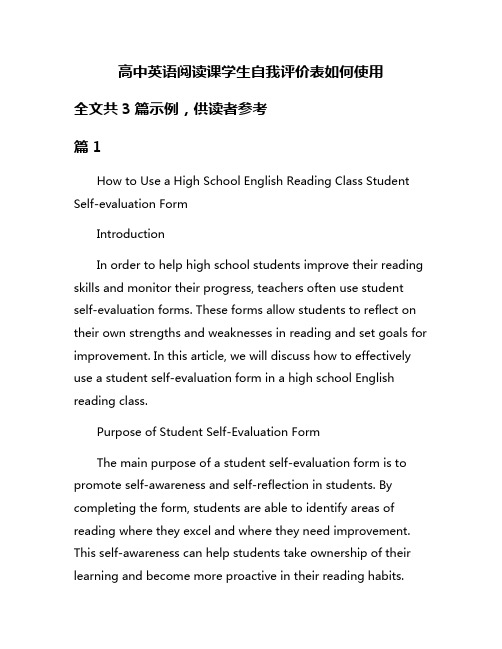
高中英语阅读课学生自我评价表如何使用全文共3篇示例,供读者参考篇1How to Use a High School English Reading Class Student Self-evaluation FormIntroductionIn order to help high school students improve their reading skills and monitor their progress, teachers often use student self-evaluation forms. These forms allow students to reflect on their own strengths and weaknesses in reading and set goals for improvement. In this article, we will discuss how to effectively use a student self-evaluation form in a high school English reading class.Purpose of Student Self-Evaluation FormThe main purpose of a student self-evaluation form is to promote self-awareness and self-reflection in students. By completing the form, students are able to identify areas of reading where they excel and where they need improvement. This self-awareness can help students take ownership of their learning and become more proactive in their reading habits.How to Use the Student Self-evaluation Form1. Introduce the Form: At the beginning of the semester, introduce the student self-evaluation form to your class. Explain the purpose of the form and how it will be used to track progress throughout the semester.2. Schedule Regular Check-ins: Set aside time each month for students to complete the self-evaluation form. Encourage students to be honest and thorough in their responses.3. Analyze Responses: After students have completed the form, take time to review their responses. Look for patterns in their strengths and weaknesses and identify areas where intervention may be needed.4. Set Goals: Based on the student self-evaluation form responses, work with students to set specific, measurable goals for improvement in their reading skills. Encourage students to take an active role in setting their own goals.5. Monitor Progress: Throughout the semester, track students' progress toward their goals. Use the self-evaluation form as a benchmark to measure improvement and identify areas where further intervention may be needed.6. Provide Feedback: After each self-evaluation form check-in, provide students with feedback on their progress. Offer praise for areas of improvement and support for areas where students are still struggling.7. Encourage Reflection: At the end of the semester, have students complete a final self-evaluation form. Encourage students to reflect on their overall progress and identify areas where they have grown as readers.ConclusionStudent self-evaluation forms can be a valuable tool for promoting self-awareness and self-reflection in high school English reading classes. By using these forms effectively, teachers can help students take ownership of their learning and become more proactive in their reading habits. With regular check-ins, goal-setting, and feedback, student self-evaluation forms can be a powerful tool for improving reading skills and fostering a love of reading in high school students.篇2How to Use a Self-Evaluation Form for High School English Reading ClassIntroductionSelf-evaluation is a crucial tool for students to assess their progress and identify areas for improvement in their academic performance. In a high school English reading class, using a self-evaluation form can be an effective way for students to reflect on their reading skills, habits, and attitudes towards reading. This document will provide guidelines on how to use a self-evaluation form in a high school English reading class to enhance student learning and engagement.Purpose of Self-Evaluation FormThe primary purpose of a self-evaluation form in a high school English reading class is to help students assess their reading abilities, track their progress, and set goals for improvement. By completing the form regularly, students can actively monitor their reading habits, comprehension skills, and attitudes towards reading. The self-evaluation form can serve as a valuable tool for students to take ownership of their learning and make positive changes to enhance their reading performance.Components of Self-Evaluation FormA self-evaluation form for a high school English reading class should include a variety of components to assess differentaspects of reading skills and habits. Some key components to include in the form are:1. Reading Habits: Students can assess their reading habits, such as how often they read, where they read, and what type of materials they read.2. Comprehension Skills: Students can evaluate their understanding of the text, ability to analyze literary devices, and summarize the main ideas.3. Vocabulary and Grammar: Students can assess their knowledge of vocabulary words, grammar rules, and ability to use them in context.4. Engagement and Attitude: Students can reflect on their level of engagement with the reading material, interest in the text, and overall attitude towards reading.How to Use Self-Evaluation FormTo effectively use a self-evaluation form in a high school English reading class, teachers can follow these steps:1. Introduction: Explain the purpose of the self-evaluation form to students and provide guidance on how to complete it.2. Regular Assessment: Have students complete theself-evaluation form at the beginning, middle, and end of the semester to track their progress.3. Individual Feedback: Review and provide feedback on each student's self-evaluation form to identify areas for improvement and set goals for the next assessment.4. Goal Setting: Work with students to set specific and achievable goals based on their self-evaluation results to guide their reading practice.5. Reflection: Encourage students to reflect on their progress, identify strengths and weaknesses, and make adjustments to their reading habits and strategies.Benefits of Using Self-Evaluation FormThere are several benefits to using a self-evaluation form in a high school English reading class, including:1. Self-Awareness: Students become more aware of their reading habits, skills, and attitudes towards reading through regular self-assessment.2. Goal Setting: Students can set specific and achievable goals for improvement based on their self-evaluation results.3. Ownership of Learning: Students take ownership of their learning by actively monitoring their progress and making changes to enhance their reading performance.4. Teacher-Student Communication: Teachers can provide individual feedback and support to students based on theirself-evaluation results to help them succeed in their reading class.ConclusionIn conclusion, using a self-evaluation form in a high school English reading class can be a valuable tool for students to assess their reading skills, habits, and attitudes towards reading. By following the guidelines outlined in this document, teachers can effectively implement a self-evaluation form to enhance student learning and engagement in their English reading class. With regular assessment, goal setting, and reflection, students can take ownership of their learning and make positive changes to improve their reading performance.篇3High School English Reading Class Student Self-Evaluation Form UsageIntroductionSelf-evaluation is a crucial part of the learning process. It allows students to reflect on their own progress, set goals for improvement, and take ownership of their learning. In a high school English reading class, the use of a student self-evaluation form can be a powerful tool for fostering self-awareness and self-regulation in students. This document will discuss how to effectively use a self-evaluation form in a high school English reading class.Purpose of the Student Self-Evaluation FormThe student self-evaluation form serves several purposes in a high school English reading class. Firstly, it allows students to reflect on their own strengths and weaknesses in reading comprehension, vocabulary, and critical thinking skills. By identifying areas for improvement, students can set specific and achievable goals for their learning.Secondly, the self-evaluation form provides teachers with valuable insight into each student's learning progress. Teachers can use the information gathered from the self-evaluation forms to tailor their instruction to meet the diverse needs of their students. Additionally, teachers can use the self-evaluation forms to monitor student progress over time and track the effectiveness of their teaching strategies.How to Use the Student Self-Evaluation FormThe student self-evaluation form should be administered periodically throughout the school year. It is recommended to distribute the form at the beginning, middle, and end of each semester to track student progress and growth. Students should be given ample time to complete the form in a quiet and reflective environment.The self-evaluation form should include a variety of questions that prompt students to reflect on their reading skills, study habits, and overall learning experience. Some sample questions for a high school English reading class self-evaluation form could include:- What are your strengths in reading comprehension?- What are your areas for improvement in reading comprehension?- How do you study vocabulary words effectively?- What strategies do you use to understand difficult texts?- How do you approach reading assignments in class and at home?- What goals do you have for improving your reading skills this semester?After students have completed the self-evaluation form, teachers should review the responses and provide personalized feedback to each student. Teachers can use the self-evaluation forms as a basis for individual conferences with students to discuss their progress, set goals, and develop action plans for improvement.Benefits of Using the Student Self-Evaluation FormThere are several benefits to using a student self-evaluation form in a high school English reading class. Firstly, theself-evaluation form promotes student accountability and ownership of learning. By reflecting on their own strengths and weaknesses, students take an active role in identifying areas for growth and setting goals for improvement.Secondly, the self-evaluation form fosters self-awareness and metacognitive skills in students. By engaging inself-reflection, students develop a deeper understanding of their own learning processes and become more strategic andself-regulated learners.Additionally, the self-evaluation form provides teachers with valuable information about each student's learning needs and progress. Teachers can use the data gathered from theself-evaluation forms to differentiate instruction, provide targeted support, and monitor student growth over time.ConclusionIn conclusion, the student self-evaluation form is a valuable tool for promoting self-awareness, self-regulation, and student ownership of learning in a high school English reading class. By using the self-evaluation form effectively, teachers can empower students to take control of their learning, set goals for improvement, and make meaningful progress in their reading skills. The self-evaluation form is a powerful tool for fostering a growth mindset and creating a culture of continuous improvement in the classroom.。
初中英语新命题趋势
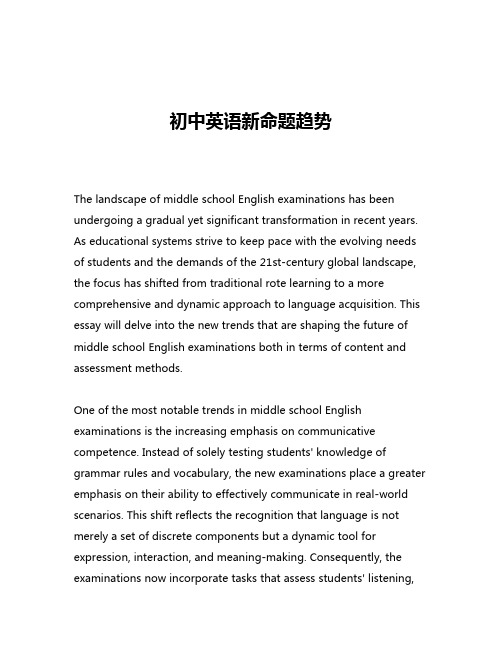
初中英语新命题趋势The landscape of middle school English examinations has been undergoing a gradual yet significant transformation in recent years. As educational systems strive to keep pace with the evolving needs of students and the demands of the 21st-century global landscape, the focus has shifted from traditional rote learning to a more comprehensive and dynamic approach to language acquisition. This essay will delve into the new trends that are shaping the future of middle school English examinations both in terms of content and assessment methods.One of the most notable trends in middle school English examinations is the increasing emphasis on communicative competence. Instead of solely testing students' knowledge of grammar rules and vocabulary, the new examinations place a greater emphasis on their ability to effectively communicate in real-world scenarios. This shift reflects the recognition that language is not merely a set of discrete components but a dynamic tool for expression, interaction, and meaning-making. Consequently, the examinations now incorporate tasks that assess students' listening,speaking, reading, and writing skills in integrated, contextual settings.For instance, students may be required to engage in role-play activities, where they must demonstrate their ability to navigate conversations, negotiate meaning, and respond appropriately to various conversational cues. Additionally, the examinations may include tasks that require students to read and comprehend authentic texts, such as newspaper articles or literary excerpts, and then produce written responses that showcase their critical thinking and analytical skills. This holistic approach to language assessment not only better reflects the demands of the modern workplace but also encourages students to develop a more well-rounded proficiency in the English language.Another significant trend in middle school English examinations is the increased emphasis on digital literacy and technology-enhanced assessment. As the world becomes increasingly digitized, it is essential that students develop the skills and competencies necessary to thrive in a technology-driven environment. Consequently, many middle school English examinations now incorporate digital components, such as multimedia-based tasks, online collaborative activities, and computer-based testing.These digital elements serve multiple purposes. First, they help to prepare students for the technological demands they will face intheir future academic and professional pursuits. By familiarizing themselves with digital tools and platforms, students gain valuable experience that will enhance their overall competitiveness. Additionally, the integration of technology-enhanced assessment methods allows for more dynamic and authentic evaluation of students' language skills. For example, students may be required to create digital presentations, engage in online discussions, or utilize language-learning software to demonstrate their proficiency.Furthermore, the incorporation of technology-based assessment can also lead to more efficient and accurate data collection, enabling educators to better understand students' strengths, weaknesses, and areas for improvement. This, in turn, can inform the development of more targeted and personalized instructional strategies, ultimately enhancing the overall quality of English language education.Another emerging trend in middle school English examinations is the increased emphasis on interdisciplinary and cross-curricular integration. In recognition of the interconnected nature of academic disciplines, many educational systems are now encouraging a more holistic approach to language learning. This means that middle school English examinations may incorporate content and skills from other subject areas, such as history, science, or social studies.For instance, students may be required to read and analyze textsrelated to environmental issues, and then produce written responses that demonstrate their understanding of both the language and the underlying scientific concepts. This approach not only reinforces the relevance of English language skills in various academic and real-world contexts but also fosters a deeper understanding of the interconnectedness of different fields of knowledge.Additionally, the integration of cross-curricular elements in English examinations can help students develop critical thinking, problem-solving, and interdisciplinary skills – all of which are highly valued in the modern workforce. By engaging with content that spans multiple disciplines, students learn to make connections, synthesize information, and apply their knowledge in innovative ways.Finally, a significant trend in middle school English examinations is the growing emphasis on personalized and adaptive assessment. As educators recognize the diverse learning needs and abilities of students, there has been a shift towards assessment methods that are tailored to individual learners. This may involve the use of adaptive testing algorithms, where the difficulty of the questions adjusts based on the student's performance, or the incorporation of personalized feedback and learning pathways.By adopting a more personalized approach to assessment, middle school English examinations can better accommodate the uniquestrengths, weaknesses, and learning styles of each student. This, in turn, can lead to more accurate and meaningful evaluation of their language proficiency, as well as more effective instructional interventions and support.Moreover, the incorporation of personalized and adaptive assessment methods can also foster greater student engagement and motivation. When students feel that the examination process is designed to support their individual learning needs, they are more likely to approach the assessment with a sense of ownership and investment, ultimately leading to better performance and a more positive learning experience.In conclusion, the landscape of middle school English examinations is undergoing a significant transformation, driven by the need to keep pace with the evolving demands of the 21st-century global landscape. The new trends discussed in this essay – the emphasis on communicative competence, the integration of digital literacy and technology-enhanced assessment, the incorporation of interdisciplinary and cross-curricular elements, and the focus on personalized and adaptive assessment – all reflect a concerted effort to create a more comprehensive, dynamic, and learner-centered approach to language evaluation.As these trends continue to shape the future of middle schoolEnglish examinations, educators, policymakers, and students alike will need to adapt and embrace these changes. By doing so, we can ensure that the assessment of English language proficiency not only accurately reflects the true abilities of students but also prepares them for the challenges and opportunities that lie ahead in the ever-evolving global landscape.。
submit是什么意思
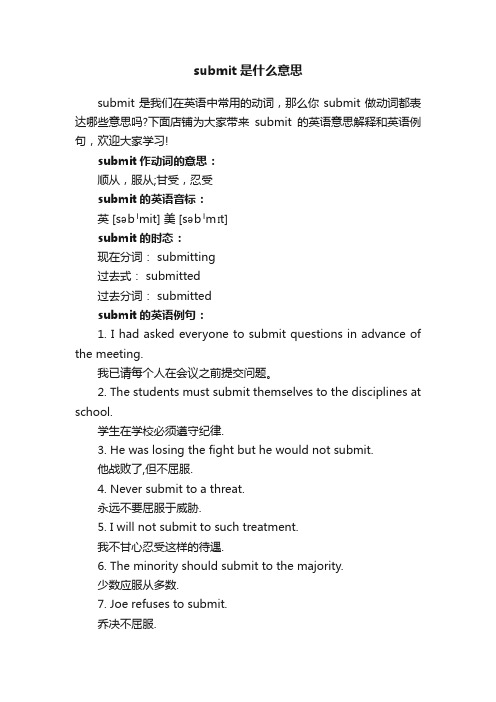
submit是什么意思submit是我们在英语中常用的动词,那么你submit做动词都表达哪些意思吗?下面店铺为大家带来submit的英语意思解释和英语例句,欢迎大家学习!submit作动词的意思:顺从,服从;甘受,忍受submit的英语音标:英 [səbˈmit] 美 [səbˈmɪt]submit的时态:现在分词: submitting过去式: submitted过去分词: submittedsubmit的英语例句:1. I had asked everyone to submit questions in advance of the meeting.我已请每个人在会议之前提交问题。
2. The students must submit themselves to the disciplines at school.学生在学校必须遵守纪律.3. He was losing the fight but he would not submit.他战败了,但不屈服.4. Never submit to a threat.永远不要屈服于威胁.5. I will not submit to such treatment.我不甘心忍受这样的待遇.6. The minority should submit to the majority.少数应服从多数.7. Joe refuses to submit.乔决不屈服.8. I submit that this should be allowed.我想这是可以允许的.9. I submit to your superior judgement.我接受你的明智的判断.10. Following this critique, students rewrite their papers and submit them for final evaluation.学生们遵照这一评语修改了他们的论文,并交上去进行最后的评审。
STUDENTEVALUATION:学生评价
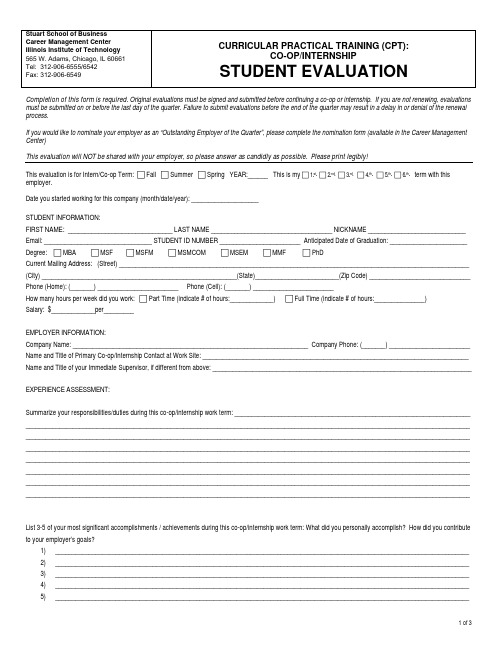
Stuart School of BusinessCareer Management Center Illinois Institute of Technology 565 W. Adams, Chicago, IL 60661 Tel: 312-906-6555/6542Fax: 312-906-6549CURRICULAR PRACTICAL TRAINING (CPT):CO-OP/INTERNSHIP STUDENT EVALUATIONCompletion of this form is required. Original evaluations must be signed and submitted before continuing a co-op or internship. If you are not renewing, evaluations must be submitted on or before the last day of the quarter. Failure to submit evaluations before the end of the quarter may result in a delay in or denial of the renewal process.If you would like to nominate your employer as an “Outstanding Employer of the Quarter”, please complete the nomination form (available in the Career Management Center)This evaluation will NOT be shared with your employer, so please answer as candidly as possible. Please print legibly!This evaluation is for Intern/Co-op Term: F Fall F Summer F Spring YEAR:______ This is my F 1st F 2nd F 3rd F 4th F 5th F 6th term with this employer.Date you started working for this company (month/date/year): ____________________STUDENT INFORMATION:FIRST NAME: _______________________________ LAST NAME ____________________________________ NICKNAME _____________________________ Email: ________________________________ STUDENT ID NUMBER ________________________ Anticipated Date of Graduation: _______________________ Degree: F MBA F MSF F MSFM F MSMCOM F MSEM F MMF F PhDCurrent Mailing Address: (Street) ________________________________________________________________________________________________________ (City) __________________________________________________________(State)_________________________(Zip Code) ______________________________ Phone (Home): (_______) ________________________ Phone (Cell): (_______) ________________________How many hours per week did you work: F Part Time (indicate # of hours:_____________) F Full Time (indicate # of hours:_______________)Salary: $_____________per_________EMPLOYER INFORMATION:Company Name: ______________________________________________________________________ Company Phone: (_______) ________________________ Name and Title of Primary Co-op/Internship Contact at Work Site: _______________________________________________________________________________ Name and Title of your Immediate Supervisor, if different from above: _____________________________________________________________________________EXPERIENCE ASSESSMENT:Summarize your responsibilities/duties during this co-op/internship work term: ______________________________________________________________________ ____________________________________________________________________________________________________________________________________ ____________________________________________________________________________________________________________________________________ ____________________________________________________________________________________________________________________________________ ____________________________________________________________________________________________________________________________________ ____________________________________________________________________________________________________________________________________ ____________________________________________________________________________________________________________________________________ ____________________________________________________________________________________________________________________________________List 3-5 of your most significant accomplishments / achievements during this co-op/internship work term: What did you personally accomplish? How did you contribute to your employer’s goals?1)___________________________________________________________________________________________________________________________2)___________________________________________________________________________________________________________________________3)___________________________________________________________________________________________________________________________4)___________________________________________________________________________________________________________________________5)___________________________________________________________________________________________________________________________EVALUATION OF POSITION: Please evaluate your work site and co-op/internship position below, offering an explanation if necessary.Strongly Agree Agree Neutral Disagree StronglyDisagreeExplain further, if necessary:This position provided me with an opportunity toapply what I am learning in the classroom.This position helped me develop professional skillsrelated to my degree and field of interest.There was an adequate amount of supervision andsupport at my worksite.The position helped me to clarify my career plansand goals.The position helped me to improve mycommunication skills.I was provided with an opportunity to learn aboutthe ethical standards of the profession and industryI would recommend this employer to a fellowstudent.Please provide an overall evaluation of this quarter’s co-op / internship position: F Excellent F Good F Satisfactory F Poor F Unsatisfactory Explain: ____________________________________________________________________________________________________________________________ ____________________________________________________________________________________________________________________________________ ____________________________________________________________________________________________________________________________________ ____________________________________________________________________________________________________________________________________PERFORMANCE SKILLS SELF ASSESSMENT: The categories below reflect evaluation criteria on the “Employer Evaluation Form.” We would like you to evaluate your performance using the same categories as the employer. Please include specific comments, examples and observations to support your ratings.Using the following scale, please evaluate YOUR performance at your worksite in the areas listed below by checking the appropriate box:1 – Excellent (the best or one of the best in this category)2 – Good (above average but not excellent)3 – Satisfactory (average when compared to others in this category)4 – Poor (lacking in some important aspects or less than satisfactory)5 – Unsatisfactory (lack of ability, failure to use it, or any other cause)NA – not applicable, or no opportunity to use these skillsRating ScalePERFORMANCE SKILLS1 Excellent2Good3Satis.4Poor5Unsat.NANotApplicableCOMMENTS, EXAMPLES AND/OR OBSERVATIONSVERBAL COMMUNICATION: Speaks with clarity and confidence Exhibits good listening/questioning skillsWRITTEN COMMUNICATION:Writes clearly and concisely ANALYTICAL ABILITY:Solves problems / makes decisions LEARNING / THEORY AND PRACTICE: Learns new material quickly1 Excellent2Good3Satis.4Poor5Unsat.NANotApplicableTEAMWORK:Works effectively with othersDemonstrates flexibility and adaptabilityTECHNOLOGY:Understands the technology of theindustry/discipline.SUPERVISION:Responds to feedback and direction fromsupervisorsPROFESSIONAL BEHAVIOR:Dresses professionallyExhibits good time management skillsBehaves professionally with respect tolanguage, boundaries, diversity, etc…Punctual/good attendanceWORK ETHIC:Work is of high-quality and appropriate volumeShows initiative and is self-motivatedIf in a LEADERSHIP role, please rate:Gives direction, guidance and trainingIf you are continuing in this position, what are your learning and/or professional goals for the next co-op work term?:•___________________________________________________________________________________________________________________________ •___________________________________________________________________________________________________________________________ •___________________________________________________________________________________________________________________________ •___________________________________________________________________________________________________________________________ •___________________________________________________________________________________________________________________________Student Signature: __________________________________________________________________________________ Date: ___________________________Academic Advisor Signature: _________________________________________________________________________ Date: ___________________________DO NOT WRITE BELOW THIS LINE – FOR CAREER SERVICES USE ONLYCMC Checklist:_______ Worked prescribed dates._______ Submitted Student Evaluation on time. _______ Submitted Employer Evaluation._______ Received satisfactory or above rating from employer.Career Services Signature: _____________________________________________________________________________ Date: ___________________________ Comments: __________________________________________________________________________________________________________________________ ____________________________________________________________________________________________________________________________________ ____________________________________________________________________________________________________________________________________ ____________________________________________________________________________________________________________________________________。
英文简历字体段落格式要求
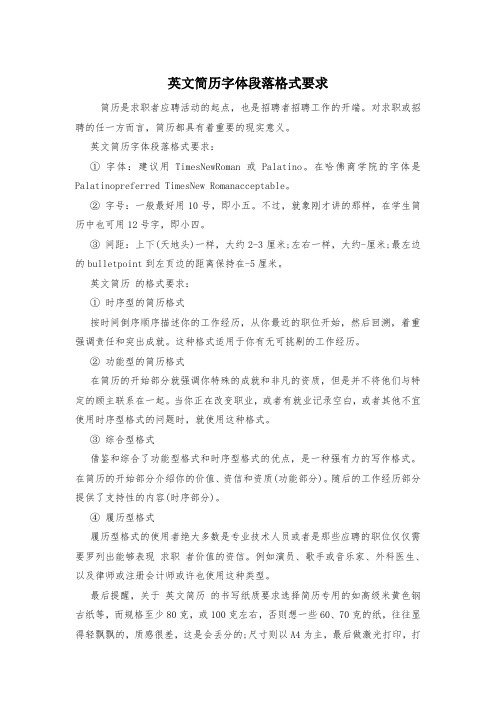
英文简历字体段落格式要求简历是求职者应聘活动的起点,也是招聘者招聘工作的开端。
对求职或招聘的任一方而言,简历都具有着重要的现实意义。
英文简历字体段落格式要求:① 字体:建议用TimesNewRoman或Palatino。
在哈佛商学院的字体是Palatinopreferred TimesNew Romanacceptable。
② 字号:一般最好用10号,即小五。
不过,就象刚才讲的那样,在学生简历中也可用12号字,即小四。
③ 间距:上下(天地头)一样,大约2-3厘米;左右一样,大约-厘米;最左边的bulletpoint到左页边的距离保持在-5厘米。
英文简历的格式要求:① 时序型的简历格式按时间倒序顺序描述你的工作经历,从你最近的职位开始,然后回溯,着重强调责任和突出成就。
这种格式适用于你有无可挑剔的工作经历。
② 功能型的简历格式在简历的开始部分就强调你特殊的成就和非凡的资质,但是并不将他们与特定的顾主联系在一起。
当你正在改变职业,或者有就业记录空白,或者其他不宜使用时序型格式的问题时,就使用这种格式。
③ 综合型格式借鉴和综合了功能型格式和时序型格式的优点,是一种强有力的写作格式。
在简历的开始部分介绍你的价值、资信和资质(功能部分)。
随后的工作经历部分提供了支持性的内容(时序部分)。
④ 履历型格式履历型格式的使用者绝大多数是专业技术人员或者是那些应聘的职位仅仅需要罗列出能够表现求职者价值的资信。
例如演员、歌手或音乐家、外科医生、以及律师或注册会计师或许也使用这种类型。
最后提醒,关于英文简历的书写纸质要求选择简历专用的如高级米黄色钢古纸等,而规格至少80克,或100克左右,否则想一些60、70克的纸,往往显得轻飘飘的,质感很差,这是会丢分的;尺寸则以A4为主,最后做激光打印,打印前后要反复检查,避免书写错误并做及时修改。
英文简历内容一:Name:gender: femaleAge: 24 height: 160 cmMarital status: single address: chang DE cityJob objectiveRecent work position:Expect post properties: full-timeExpected monthly salary: 20xx ~ 3000Expect engaged in post: executive director, sales director, sales engineers, cost manager, accounting supervisorExpect engaged in industry: puter software, accounting, financial (investment, financial (bank), academic researchSelf evaluationI am hunan engineering institute of international economy and tradea fresh graduates. Get accountant from job seniority card, English level 4, national puter level 2, customs declarer certificate and etc.Not petitive, but always petitive. University students once was appointed deputy director of the office of the department, each year during the period of school scholarship and obtained the country pursues a scholarship, was awarded triple-a student, outstanding student cadres. In the youth have a passionate heart, do not the best, only better. Not superstitious himself, but always believe in your ability. My major foundation is good, learning ability, and good character,Education experienceStart-stop years: in September 20xx to June 20xxThe school name: hunan college of engineeringProfessional name: international economy and tradeDegree: bachelor degreeInternship experienceStart-stop date: in May 20xx to June 20xxEnterprise name: xiangtan TCLIn position: sales promotion memberPerformance: learning a lot of sales experience, learned and the munication between different groups.英文简历内容二:Name:nationality: ChinaAt present location: yuexiu district of national: the han nationality The registered permanent address locus: yuexiu district of figure: 168 cm 50 kgMarital status: single age:Job objectiveTalent type: ordinary jobApplied position: administrative: administrative assistant, administrative assistant, financial: financial accounting, cashier, logistics, warehouse, puter administrator, typing operatorTerm: the title: no titleJob type: all can date available: at any timeMonthly salary requirement: negotiable hope work areas: yuexiu district of guangzhouWork experience:pany name: the core technology paniesStart-stop years: 20xx01 ~ 20xx-08The pany properties: by sector:In the position of: civilian financialJob description: answer the call, be responsible for the daily office work, etc, to send and receive mail, to proceed the exit procedure, issue pensation, etcSelf evaluationMy undergraduate course graduation, during the school work hard to make progress, respect teacher, and students get along well, take an active part in social practice, learning skills is mitted to sharing society. My English is good, has joined the CET 4 levels of tests, and access to national public oral English certificate. I hold accountant from job seniority card (accountant), national puter level certificate. Skilled I can play wubi, grasps the OFFICE20xx office software and puter skills, have two years of civilian work experience and two years cashier financial experience. I would like to play for the expensive unit of his strength and ability, please the expensive unit can give me the chance of playing. Education backgroundGraduate school: jinan universityThe highest degree: undergraduate course graduation date: the 20xx-01-01Major one: puter network engineering major 2:英文简历内容三:Name:sex don’t: malePeople family: the han nationality date of birth: on March 28,Telephone number: marriage status:Body high: 168 cm body weight: 56 kgEducation experienceGraduate school: liaoning engineering technology university calendar: bachelor degreeProfessional name: electrical automation measurement and control technology and instrument graduation year: 20xxWork experience: four years the highest title:Job objectivePosition properties: the whole jobJob category: energy technologyEngineeringotherPosition title: technicians, engineers,Work areas: fujian - fuzhou city;Salary: 3000-4000 yuan can be negotiated; Does not need to provide housingStarting time: may at any time to workSkill expertiseLanguage: English;puter level: the national associate constructor card (electrical and mechanical engineering)Driving license C1 cardWork experiencepany: xiamen cernet special electronic co., LTDTime range: in September 20xxThe pany properties: private panySubordinate industry: electronics, microelectronics technologyPosition: product keeper简历是求职者应聘活动的起点,也是招聘者招聘工作的开端。
- 1、下载文档前请自行甄别文档内容的完整性,平台不提供额外的编辑、内容补充、找答案等附加服务。
- 2、"仅部分预览"的文档,不可在线预览部分如存在完整性等问题,可反馈申请退款(可完整预览的文档不适用该条件!)。
- 3、如文档侵犯您的权益,请联系客服反馈,我们会尽快为您处理(人工客服工作时间:9:00-18:30)。
CAR-TR-672CS-TR-3069May 1993STUDENT EVALUATION OF THE SOFTWAREIN THEAT&T TEACHING THEATERDiane Lindwarm and Kent L. NormanDepartment of Psychologyand theHuman/Computer Interaction LabUniversity of MarylandABSTRACTThe AT&T Teaching Theater is a highly interactive, multimedia electronic classroom at the University of Maryland offering instructors many new and creative teaching opportunities. Although this technology may hold many exciting possibilities, it is important to not lose sight of the main objective of any teaching facility - the students. Therefore, the important questions are: "How do students rate the AT&T Teaching Theater? What are their opinions of the various types of software programs currently offered? Do they facilitate or interfere with the learning process?" This paper discusses the results from a survey of students who attended classes in the AT&T Teaching Theater, Fall semester, 1992. A comparison among the different types of software used by the various instructors is the focus for this evaluation. In particular, HyperCourseware, a program providing an "electronic infrastructure" for computer based education will be at the center of this comparison. HyperCourseware is a "work in progress" and is one of the few software packages used in the electronic classroom designed with the Teaching Theater in mind. The findings from this paper will be used to determine where improvements need to be made in order to benefit the students and to make the most of the technology offered in the AT&T Teaching Theater in the future.INTRODUCTIONCreating better environments for students is a priority for most of today's educators. As we move into the future, it will become increasingly important for these educators to develop new methods for challenging and stimulating students academically . Technology provides a means for creating just such an atmosphere . By bringing together education and technology, the electronic classroom, attempts to offer a first step in the solution. An electronic classroom is a special room which provides computers for the students, networked and linked up with an instructor's computer. The electronic classroom offers students a certain potential of control over the learning process, as well as the ability to give input and feedback to the instructors. With the aid and convenience of technology, instructors now have the opportunity to provide more creative, flexible programs and to stimulate the students through a variety of media.However, with such opportunities for advancement come problems. Since the electronic classroom is based on a computer network, all of the processing limitations often found in new systems, such as speed and reliability must be dealt with. In addition, for the classroom to really be used to potential, the instructors, currently, must spend more time in preparation for each lesson. What then, is the net loss or gain to the students? Do these problems interfere significantly with the learning process, or are they merely minor hassles which will eventually be eliminated and will allow the student to fully enjoy the benefits of the electronic classroom?This paper uses as it's model, the AT&T Teaching Theater at the University of Maryland at College Park, Maryland. Previous research has evaluated the Teaching Theater in terms of its physical configuration and usability (Norman & Lindwarm, 1993; Norman & Carter, 1992). In this study, a comparison among the various software products currently used in the Teaching Theater will be made, with a specific focus on HyperCourseware, a specialized software package, developed primarily for the Teaching Theater.The ClassroomThe layout of the AT&T Teaching Theater is a lecture-style setup with the instructor at the head of the classroom facing the students. Figure 1 shows a schematic for this classroom at the University of Maryland. The instructor's desk contains the equipment necessary to operate all of the media in the classroom and to interface with the students' computers. The media used in the classroom includes: two 4'x 6' high resolution rear projection screens, a video overhead projector, a VCR, a video disc player and a CD player. In addition, the instructor has access to all of the students' machines, and using a video switcher, may display the contents of any student's screen on the instructor's monitor, which may in turn may be displayed on the front screen and/or on the other students' monitors. Finally the instructor has the capability to "take over" a student's display, to assist or make corrections.Figure 1. A schematic of the basic layout of the AT&T Electronic Teaching Teacher.Twenty Student Workstations with Two Students Per WorkstationThe students have access to 20 personal computer workstations (each workstation can serve two students - allowing for a total of 40 students per class). Each workstation is equipped with a keyboard, a mouse and a 17" high resolution color monitor, which is recessed into the desk to allow for good sight lines and to conserve space. The computers may be used to present class information (overheads, lecture notes, reading material), as scratch pads, for note-taking, or for computing purposes (programming, word processing, and networking).The supporting computer systems are AT&T 25 MHz 386-based units. The computers are linked through an AT&T Starlan™ network, then through a Novell™server and are eventually linked to the Internet, thus allowing students outside access to their accounts. For noise reduction, as well as comfort, the AT&T Teaching Theater is carpeted and the computer units are housed in an adjacent room. Environmental control for lighting is controlled by the control panel at the instructor's workstation.SoftwareA major focus of this paper is the comparison among the many types of software packages used in the teaching theater. Table 1 in the Appendix shows the courses and their associated software packages used in the Teaching Theater for Fall semester 1992.The following descriptions of the software products used in the Teaching Theater will give some insight into the breadth and variety of software used in the Teaching Theater.Chat: A Novell™ utility that allows the users to "talk"interactively on-line with each other. Chat is agroupware product which allows and encourages userinteraction.WordPerfect: A stand alone, DOS-based word processor withautomatic referencing, document comparison,dictionary and thesaurus, mouse support, mail merge,macros, table of contents generator, and text-integrated graphics.Quattro Pro: A spreadsheet that allows consolidation of data frommore than one spreadsheet into a single spreadsheet,graph or chart. Quattro Pro has extensive spreadsheetpublishing and graphics features for use inpresentations, and a built-in draw program that allowsyou to edit you charts and graphs. Quattro Pro isprimarily a stand alone product.SAS: A single user statistical package designed for dataanalysis and report generation.GEDS: The Global Events Database Editor was used in aGovernment/Politics class on "Conflict and PeaceAnalysis". It is a single user product. Visionquest:Marketed as a group decision support system(GDSS), VisionQuest offers a collaborativeenvironment for sharing of ideas anonymously.Various tools in this system, especially brainwritingand comment cards, can be used in the academicsetting for supporting a collaborative learningenvironment.HyperCourseware:"A system of interlocking programs and files thatserves as an electronic infrastructure by creatingtokens on a computer network that represent thefamiliar objects of instruction such as the syllabus, theclass roll, lecture notes, exams, and grade lists."(Norman & Lindwarm, 1993)Paradox: A relational database manager that allows the user toaccess and manipulate data in many ways. The usercan perform calculations, create graphs, and regroupinformation.Most of these products are "Off-the-shelf" and were therefore, not designed specifically for the Teaching Theater. They have the advantage, though, of having gone through extensive product development and rigorous testing. In addition, most of these products work mainly as "stand alone" programs, that is they are intended for use by a single individual. A few of these products are actually intended for communication and decision-making purposes, and are used as such in the Teaching Theater. HyperCourseware, however, is the only product designed for the specific requirements and goals of the Teaching Theater by combining teacher-directed instruction with student input and the capability for interaction. Therefore, the development of HyperCourseware will be a primary focus of this paper. Issues concerning current usability problems will be addressed so as to better understand how this product can be improved for future use in the Teaching Theater.HyperCoursewareDescribed as an "electronic infrastructure", HyperCourseware creates an environment in which the instructor can create lectures and discussion platforms, interactive experiments, surveys, quizzes and much more. In addition, the students and instructor can view the current day's seating chart, notes from previous classes, mail messages from the instructor or other classmates and can look ahead to upcoming classes by browsing the course syllabus. HyperCourseware attempts to utilize what is best about the Teaching Theater -the ability to combine lectures and student participation in one package. Figure 2 shows several examples of HyperCourseware screens.Figure 2.Examples of HyperCourseware Screens.METHODSubjectsThirteen classes were taught in the AT&T Teaching Theater in a variety of subjects ranging from English to Computer Science (see Table 1 in the Appendix), allowing for a varying degree of prior computer experience and course content. Each class had up to 40 students enrolled. In addition, the course offering ranged from undergraduate level to graduate level. Of the thirteen classes, eight participated in the survey, and five of the classes administered the survey on-line. The remaining three classes were administered as paper and pencil questionnaires. In addition, one course with a small enrollment was not counted in the final calculations as only one student participated in the survey. Participation was voluntary and the students were told that their answers and remarks would not have any effect on their grade in the course.QUISThe Questionnaire for User Interaction Satisfaction version 5.5 is a general test for usability which measures a user's subjective satisfaction with a particular interface (Chin, Diehl, & Norman, 1988; Harper & Norman, 1993). Questions used in the QUIS range from general interface satisfaction (i.e. Overall reaction to the system) to more detailed interface questions (i.e. rating the helpfulness of error messages). In addition, the QUIS has the capability of being tailored to the specific application being rated (i.e. "Were technologies in the classroom used to full potential?") The layout of the QUIS for this survey was as follows:PARTS 1& 2: System and demographic information.PART 3: Overall User Reactions (6 questions)PART 4: Screen (4 questions)PART 5: Terminology and System Information (6 questions)PART 6: Learning (6 questions)PART 7: System Capabilities (5 questions)PART 8: Media Effect (4 questions)PART 9: Technology (4 questions)PART 10: Accessibility (1 question)Each of the questions in parts 3-10 consisted of a 9 point (1-9) scale with an option of n/a for those questions which were not applicable.Evaluation ProcedureDuring the last week of the semester, all of the students attending the Fall 1992 semester classes were administered the QUIS either on-line or in paper form. As noted in the previous section, students were asked to evaluate the software and other media in theAT&T Teaching Theater. Data were grouped according to combinations of Software used (see Table 1 in the Appendix). In some cases, two software products were grouped together for evaluation (such as WordPerfect with Chat, and Quattro Pro with SAS) since they were used together in a particular course. Unfortunately, since the survey did not distinguish between the two products the results cannot be clearly differentiated.RESULTSTable 2 lists the means for satisfaction on the overall reactions to the Teaching Theater. Since these values are highly correlated, a total score was calculated for each type of software. Table 3 gives mean satisfaction ratings for the more detailed information and Table 4 shows mean responses for AT&T-specific questions. Within each table the boldfaced items indicate significant differences among the products. The values, themselves, which are highlighted, represent specific significant contrasts. From these data, it is evident that overall, Quattro Pro had higher ratings as compared to HyperCourseware and Visionquest. In particular, questions concerning overall reaction (p<0.01), overall stimulation (p<0.05) and overall power (p<0.05) of the system, showed significant differences depending on the software used. This difference is also reflected in the Overall Totals score (p<0.01). For overall reaction, Quattro Pro and GEDS came out on top and HyperCourseware and Visionquest rated significantly lower. Additionally, Quattro Pro rated highly on questions involving system speed (p<0.01), reliability(p<0.01), (limited) media interference (p<0.05), and media helpfulness (p<0.05). Other areas which showed significant differences among the products include: how often the computer informs the user about what it is doing (p<0.05), computer helpfulness (p<0.05) and adequacy of learning time (p<0.05). Quattro Pro and GEDS were rated significantly higher than Visionquest and Paradox on the question of how much improvement the student experienced with the system (p<0.01). HyperCourseware also rated well with respect to Paradox on this question (p<0.05).Although these data may at first look somewhat discouraging with respect to HyperCourseware, it is important to note that almost all of the mean scores for each set of data fall above the benchmark score of 5 on the scale. Graph 1, in the appendix, shows a scatterplot of the overall mean for the data with one standard deviation above and below the mean designated by the accompanying bars. It is interesting to note some of the outlying points on this scatterplot. Questions 4.1 (regarding readability of characters on the computer screen) and 7.3 (Noise of the system) both rated quite high (favorably) with overall means of 7.84 and 8.15 respectively. Conversely, questions 5.6 (Helpfulness of error messages) and 10.1 (Accessibility of the system from the Workstations at Maryland (WAM) labs) rated considerably poorer than the rest of the scores with overall means of 6.04 and 4.73. Similar results were shown in Graph 2 which gives the same information exclusively for HyperCourseware scores. Overall, the data reflects a rating in subjective user satisfaction well over the benchmark score of 5 on the 9-point scale, with the same issues noted as noticeably divergent scores.DISCUSSIONAs can be seen from the data collected, there are many discrepancies in student satisfaction with regards to the types of software used the Teaching Theater. On the one hand, the variety of software products demonstrates the great flexibility and diversity which the Teaching Theater has to offer. On the other hand, the great degree of variability among the different products makes them difficult to reliably compare. However, the purpose of this survey is to get a "feel" for how the students are responding to the Teaching Theater -whether the Teaching Theater provides a positive experience for the student(which it apparently does) and better understand some of its current shortcomings. In particular, the usefulness of HyperCourseware as a teaching tool should be evaluated, as it is a work in progress designed specifically for the AT&T Teaching Theater. From the data it is clear that HyperCourseware falls short in user satisfaction on a number of factors. These include: (a) Overall Reaction, (b) System Speed, (c) Reliability, (d) Media Helpfulness and (e) Media Interference. It did however, fare well regarding student improvement with computer usage over the semester.It is necessary to mention here, that although we were able to gather some interesting feedback from the students, we were not able to control for a number of confounding effects of students groups and classes. The confounding factors include: experience levels of students between classes, the range in degree of difficulty and type of course curriculum (Statistics vs. History vs. Computer science vs. English), the level of involvement of the computer and the format of the class - lecture vs. discussion vs. group projects, etc. These confounding factors prevented a truly unbiased analysis among the different software products. Nevertheless, the feedback from the students does provide some groundwork for understanding what is successful and where improvement is needed. Additionally, it gives some suggestions about the advantages and shortcomings of HyperCourseware.What is important to note, however, is that HyperCourseware is currently under development, whereas most of the other software products are fully developed marketed products. The factors regarding speed and reliability are heavily tied into the process of development - that is, newer programs that are in the development phase tend to be slower and less reliable. As for the interference of media - this is probably due to the high degree of media interaction used in these courses which utilized HyperCourseware. Again, the slow speed of processing probably added to the frustration level of the students and caused them to feel that the media interfered with their learning. Finally, it is interesting to note that the students felt that their ability to use the computer improved significantly during the semester. This is probably due to the fact that HyperCourseware required a great degree of user interaction. Overall, many of the features which cause HyperCourseware's low relative scores, are also factors which should improve through the normal course of the development cycle. Keeping in mind that HyperCourseware is a work in progress, it is important to understand that it, like the Teaching Theater, is being developed not just for the current classroom, but also for the classroom of the future. The main goal is to provide an enriching atmosphere for learning which will inspire students and promote a high level of academic performance.ACKNOWLEDGMENTSPartial support for this project was provided by a grant from AT&T Information Systems and the Computer Science Center at the University of Maryland. We wish to thank Walt Gilbert, Project Director of the AT&T Teaching Theater and Ellen Yu, Project Manager, for their support as well as the pioneering instructors and students who are exploring learning in the electronic classroom.REFERENCESBlack, A., et. al. (1992). Consulting on-line dictionary information while reading.MRC Applied Psychology , 4, 145-168.Chin,, J.P., Diehl, V.A., & Norman, K.L. (1988). Development of an instrumentmeasuring user satisfaction of the human-computer interface. In CHI '88 Conference Proceedings: Human Factors in Computing Systems, (pp.213-218), New York:Association for Computing Machinery.Harper, B. D., & Norman, K.L., (1993). Improving user satisfaction: Thequestionnaire for user interaction satisfaction version 5.5. Proceedings of theMid-Atlantic Human Factors Conference, Virginia Beach, February, 224-228. Norman, K.L.(1992). Defining and Assessing Usability in Emerging Systems: A Case Study of the Electronic Classroom. Submitted for the Proceedings ofUsability Concepts and Procedures: Third Conference on Quality Documentation.November 19-21, 1992. University of Waterloo.Norman, K.L. & Carter, L.E. (1992, May). A Preliminary Evaluation of the Electronic Classroom: The AT&T Teaching Theater at the University of Maryland.(CAR-TR-621 and CS-TR-2891). Department of Psychology and Human/Computer Interaction Laboratory, University of Maryland, College Park, MD.Norman K.L., & Lindwarm D. (1993). Human/computer interaction in the electronicclassroom. Proceedings of the Mid-Atlantic Human Factors Conference, VirginiaBeach, February, 217-223.APPENDIXTable 1: Software Products and their associated courses:SOFTWAREPRODUCTCOURSE TYPEChat ENGL (English)WordPerfect ENGL (English)Quattro Pro ANTH (Anthropology), BMGT, (Business & Management) ENCE(Civil Engineering), HIST (History)SAS ANTH (Anthropology)GEDS GVPT (Government & Politics)Visionquest BMGT (Business & Management), ENGL (English) HyperCourseware PSYC (Statistics for the Behavioral Sciences), PSYC (Psychology) Paradox CMSC (Computer Science), ENCE (Civil Engineering)Table 2:Mean ratings on a 9-point scale (1-9) :Notes (regarding the following 3 tables):** = Significant difference(s) at the 0.01 level - (contrasts designated by bold type)* = Significant difference(s) at the 0.05 level - (contrasts designated by bold type)Comparisons among the various software products were analyzed by Scheffe F-test.a) Overall (General) Measurements:DESCRIPTION WP / CHAT QUATTROPRO / SAS GEDS VISION-QUESTHYPER-COURSE-WAREPARADOXOverall Reaction**7.158.008.17 6.27 6.11 6.34 Overall satisfaction7.237.297.08 5.88 6.08 6.05 Overall stimulation*7.387.717.58 6.24 5.76 6.13 Overall ease7.467.077.25 6.69 6.627.05 Overall power*7.157.937.17 6.55 6.05 5.66 Overall flexibility7.15 6.717.00 5.98 5.84 6.11 TOTALS**7.257.457.37 6.27 6.08 6.22Table 3:b) Nonspecific Software Measurements:DESCRIPTION WP / CHAT QUATTROPRO / SAS GEDS VISION-QUESTHYPER-COURSE-WAREPARADOXReadability of chars7.838.147.757.847.897.58 Help of highlighting7.587.368.337.237.037.26 Help of screen layouts7.407.368.17 6.63 6.797.12 Clear screen sequence7.677.50 6.90 6.59 6.79 6.94 Consistent use of terms7.227.407.70 6.437.13 6.79 Relative terminology 6.807.707.62 6.42 6.60 6.75 Clarity of messages7.547.277.50 6.57 6.86 6.70 Helpfulness of messages8.007.20 6.75 6.48 6.68 6.94 Computer informs* 6.807.45 6.75 5.72 5.82 5.85 Help of Error messages 6.18 6.80 6.73 5.96 4.61 5.94 Ease of learning8.007.177.42 6.497.08 6.90 Exploring Encouraged*7.337.558.00 6.38 6.74 6.89 Ease of remembering 6.67 6.777.08 6.087.24 6.29 Straightforward tasks 6.917.087.67 6.54 6.66 6.89 Clarity of Help msgs7.00 6.91 6.67 6.17 5.80 6.08 Clarity of suppl. refs7.307.50 6.30 5.32 5.89 5.36 System speed**7.408.507.08 6.69 5.24 5.82 R e l i a b i l i t y**7.408.27 6.92 6.72 5.50 6.05 Noise of system8.408.588.587.678.327.35 Ease of correction7.507.837.75 6.67 6.50 6.50 All levels of experience7.00 6.427.00 5.84 6.29 6.51 Table 4:c) AT&T Teaching Theater-Specific Measurements:DESCRIPTION WP / CHAT QUATTROPRO / SAS GEDS VISION-QUESTHYPER-COURSE-WAREPARADOXInstructor integration n/a7.77 6.80 6.26 6.79 6.58 Media interference* n/a8.087.30 5.84 5.16 6.17 Media helpfulness* n/a8.177.00 6.12 6.05 5.42 Computer helpfulness* n/a7.797.36 6.18 6.16 5.70 Tech used to potential n/a7.36 6.67 5.88 6.00 5.06 Adequate time to learn* n/a 6.437.58 5.52 6.27 6.47 Ability to attend n/a7.087.75 6.23 6.95 6.65 Improvement** n/a8.368.50 5.69 6.27 4.08 Accessibility from WAM n/a 4.64 4.54 5.71 4.09 4.68 n/a = No data collected for this group.Graph 1: Scatterplot of Overall Ratings (for all software products combined):One Standard Deviation Error Bars for Columns: X 1...X 361234567893.54.45.56.47.38.39.4Item Number R a t i n g_________________________________________________________________Graph 2: Scatterplot of HyperCourseware Ratings: One Standard Deviation Error Bars for Columns: X 1...X 361234567893.54.45.56.47.38.39.4Item Number R a t i n g _________________________________________________________________。
